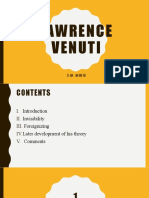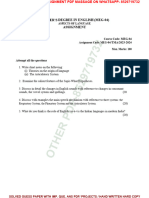Translating Cultures. Translating Iran. Domestication and Foreignization
Translating Cultures. Translating Iran. Domestication and Foreignization
Uploaded by
miss_barbaronaCopyright:
Available Formats
Translating Cultures. Translating Iran. Domestication and Foreignization
Translating Cultures. Translating Iran. Domestication and Foreignization
Uploaded by
miss_barbaronaCopyright
Available Formats
Share this document
Did you find this document useful?
Is this content inappropriate?
Copyright:
Available Formats
Translating Cultures. Translating Iran. Domestication and Foreignization
Translating Cultures. Translating Iran. Domestication and Foreignization
Uploaded by
miss_barbaronaCopyright:
Available Formats
Translation theory
Translating cultures. Translating Iran.
Hristina Racheva 536917
Domestication and foreignization strategies in the translation of Iranian short stories
Content Introduction Main body Why Iran? Why Jalal al-Ahmad? Why cultural translation? Translation and gender Domestication Foreignization Conclusion
Abstract. When faced with a novel or a short story, when dealing with cultural norms which are part of the source text but which do not exist in the target one, the translator realizes the role that culture plays in the translation process. An approach is needed to help the translator convey these cultural values to the target language, to preserve their meaning and help their understanding. By using the methods of domestication and foreignization, discussed by Venuti (1995), this process of transformation and acceptance becomes easier both for the translator and for the reader. Key words: culture, domestication, foreignization, Venuti, Jalal al-Ahmad
Translation theory
Introduction
Hristina Racheva 536917
Translation involves crossing boundaries- disciplinary, linguistic, cultural, even physical. It requires not only linguistic comprehension and knowledge of two or more languages (often called source and target languages) but as well understanding and appreciation of the cultures expressed through and embedded in these languages. Culture has for a very long time been underestimated and not much attention has been paid to its important role and its influence on the translation process. Probably the first ones to point out the inevitable interaction between translation and culture are Susan Bassnett and Andr Lefevere (1990:45), as well as the translation theorist Lawrence Venuti who insists that the scope of
translation studies needs to be broadened to take account of the value-driven nature of the sociocultural framework(Venuti, 1995).
By discussing the English translation of three short stories from the Iranian writer Jalal alAhmad, this paper aims at showing the important role that culture plays in translation, the constrains that it imposes on translators and the necessity of preserving its authenticity in order to ensure a genuine dialogue between nations and individuals. The theoretical work of Venuti and his translation strategies of domestication and foreignization will be used in order to criticize or justify the choices made by the various translators of the given Iranian short stories.
Translation theory
Main body Why Iran?
Hristina Racheva 536917
When translating literary works that belong to cultures and languages considerably different from what we geographically and culturally define as the West, the cultural barrier that the translator is confronted with becomes indispensably and instantly recognised. Such is the case with Iran and its ancient culture and customs interwoven in its literature masterpieces and expressed through the euphonious and powerfully emotive Persian language. But to what an extent are the linguistic richness and its emotional impact preserved and by which means are they conveyed in the target language? This issue becomes even more obvious when dealing with literary works of fiction, short stories and novels, which are, metaphorically speaking, a window to distant and unknown worlds, a stage where mysterious people from different cultural background act obeying customs
incomprehensible to us the observers, the readers. An example of such literary pieces is the stories and essays of the Iranian writer Jalal al-Ahmad.
Why Jalal al-Ahmad? A son of a Shiite clergy man, Jalal al-Ahmad breaks with his religious family in his students years. In 1946 he graduates from Teachers College and becomes a teacher and later pursues academic studies at Tehran University and receives an MA in Persian literature. From 1945 to 1968 he writes novels, essays, travelogues and ethnographic monographs. The subjects of his works are mainly cultural, social and political issues, symbolic representations and sarcastic expressions. In his works he pays attention to the superstitious beliefs of the
Translation theory
common people. Thus, on one hand, he is a significant writer, depicting a portray of the traditional Iranian society and culture, and on the other, his work is a significant example of that how essential the cultural issue is in the translation process and in what way, by using
Hristina Racheva 536917
what strategies, a successful translation, one which preserves these cultural values, is to be achieved. The stories that will be discussed in this paper and their respective English translations are taken from the book Iranian Society, An anthology of Writings by Jalal al-e Ahmad, compiled and edited by Michael C. Hillmann. The stories and translators names are as follows: The Unwanted Woman Zan-e Ziyadi, translation by Leonard Bogle, The University of Texas at Austin; Sehtar, translation by Terence Odlin, The University of Texas at Austin; The Sin Gonah, translation by Raymond Cowart, The University of Texas at Austin. Stories of that kind - rich in cultural representations and descriptions - establish the interaction between cultures and their translations foster the understanding of the foreign culture with its peculiarities. Due to their complexity and the important role they play in drawing societies closer, their translation needs to be fulfilled by following different strategies and taking into consideration different rules than the ones used for technical, scientific or journalistic texts, for example.
Why cultural translation?
Drawing upon the notions of the polysystem theorists like Itamar Even-Zohar, Andr Lefevere (a twentieth century translation theorist) theorized translation as a form of rewriting produced and read with a set of ideological and political constraints within the target language cultural system.
Hristina Racheva 536917 Together with Susan Bassnett he considers that "neither the word, nor the text, but the culture becomes the operational unit of translation". In their Translation, History and Culture (Bassnett and Lefevere 1990: 4) they dismiss the painstaking comparisons between originals and translations which do not consider the text in its cultural environment. Instead, Bassnett and Lefevere go beyond language and focus on the interaction between translation and culture, on the way in which culture impacts and constrains the translation.
Translation theory
Translation and gender
The interest of cultural studies in translation inevitably took translation studies away from purely linguistic analysis and brought it into contact with other disciplines. My translation practice is a political activity aimed at making language speak for women. So my signature on a translation means: this translation has used every translation strategy to make the feminine visible in language. (Lothbinire-Harwood, 1991) These are the words of the Canadian translator Lotbinire-Harwood. Feminist translation seems to have developed as a method of translating the focus on and critique of patriarchal language by feminist writers in Quebec and has as well been defined by some Canadian translators as an antitraditional, aggressive and creative approach to translation (Flotow, 1991). Feminist translations have been criticized for unveiling what the writer had deliberately concealed or left implicit. However, by mentioning the feminist approach to translation, the paper does not aim at thoroughly exhausting the topic but only at pointing out a remarkable phenomenon observed in the translation of The Unwanted Woman. The translation is done by a male translator and yet the sings of a feminist translation could be observed.
Translation theory
Hristina Racheva 536917
How is it possible for someone not to realize that her [ones] very existence is the cause of so much suffering? How is it possible for someone not to feel that she [one] is unwanted?
The Persian noun [ adam] means man and it would have been a perfectly adequate translation if the English pronoun one had been used. It would have remained neutral, i.e. it would have acquired neither feminine, nor masculine shade of meaning. Nevertheless, the translator chooses the
feminine pronoun she and her when translating these sentences and therefore emphasizes on the female character in the story and in particular on the emotional trial she is going through. A reason for that could be the Jalal al-Ahmads focus on poorer and more misfortunate people from the society and in particular on women.
Domestication
According to Venutis theory every translator should look at the translation process through the prism of culture which refracts the source language cultural norms and it is the translators task to convey them, preserving their meaning and their foreignness, to the target-language text. Every step in the translation processfrom the selection of foreign texts to the implementation of translation strategies to the editing, reviewing, and reading of translationsis mediated by the diverse cultural values that circulate in the target language (Venuti, 1995).
Hristina Racheva 536917 He estimates that the theory and practice of English-language translation has been dominated by submission, by fluent domestication. He strictly criticized the translators who in order to minimize the foreignness of the target text reduce the foreign cultural norms to target-language cultural values. It has to be acknowledged that the translators of the discussed translations have skillfully avoided the assimilation of the source culture into the target culture. And yet, there are few examples which show that they have failed to preserve the foreignness of the original - few religious terms have been fully assimilated by the source text and their value as universally established and commonly used Islamic terms has been reduced. Let us take as an example the story The Sin narrated through the thoughts of a thirteen-year old girl from a religious family.
Translation theory
.
These were the assistants in my fathers mosque and the other disciples who returned with him.
The Persian word [ muezzin] which is from an Arabic origin, designates the person at a mosque who leads the call to prayer. Thus, an adequate word which would cover the same meaning and would preserve the functions of the person implied in the word muezzin does not exist in English. Therefore, the word assistant chosen by the translator does not imply the information on the religious duties of the person and his position in the religious hierarchy that are suggested in the word muezzin. A way to handle this situation would be to keep the word in its transliterated form, muezzin, and then to provide an explanatory footnote, giving the meaning that the word implies.
Translation theory
Hristina Racheva 536917
Here is another example from the same story, once again related to the religious issue.
.
He sat on his usual place on the floor next to the preachers chair.
In this case the translator has not only assimilated the original word but has actually given a different meaning to it. The verbal noun [ rouze khan] designates a person who reads a special prayer on a particular religious holiday. Thus, the word preacher does not correspond in meaning and in the persons functions to the original term. Moreover, since these two terms refer to different religions and different religious practices they could not be used as interchangeable. Besides, in a previous sentence the translator has already faced the challenge of translating the word ( a translation which will be examined further on in the paper) and has decided to keep it in its transliterated form rowzeh. Thus, a way to translate would be by saying the reader of the rowzeh prayer. But the process of domestication does not include only linguistic and cultural assimilation. When discussing the domestication strategy and the damages it causes on the source text and respectively on the culture interwoven in it, Venuti (1995) refers to the British translator J. M. Cohen who defines the domestication as the risk of reducing individual authors styles and national tricks of speech to a plain prose uniformity (Cohen 1962: 35). When comparing the English translation of The Sin to the original text in Persian, one can see why Cohen has expressed his fear of obliterating speech and expression peculiarities typical to a particular nation or culture.
Hristina Racheva 536917 Everyone with knowledge in Persian language and comprehension of the Persian written style is accustomed to and constantly aware of the long sentence structure that exists in this language. Very often a sentence would span to three or four lines, hence forming a small paragraph on its own. Thus, reading a story abundant in numerous short sentences often consisting of no more than five or six words is immediately noticed by the reader. Here is an example from The Sin and the respective English translation which fails to adequately deliver its short sentence peculiarity. The three sentences in the Persian text have been merged into only one in English.
Translation theory
. . .
Nor did he lower his head like all the others who acted as if they were ashamed to see the tears of someone else.
Foreignization
According to Venuti, the domesticating strategy, as shown in the above examples, violently erases the cultural values and thus creates a text which as if had been written in the target language and which follows the cultural norms of the target reader. He strongly advocates the foreignization strategy, considering it to be an ethnodeviant pressure on [target-language cultural] values to register the linguistic and cultural difference of the foreign text, sending the reader abroad. Thus an adequate translation would be the one that would highlight the foreignness of the source text and instead of allowing the dominant target culture to assimilate the differences of the source culture, it should rather signal these differences. (Venuti, 1990)
Hristina Racheva 536917 With the exception of the two above examples, by using different strategies, the translators of the given short stories have very well preserved the foreignness of the source culture, expressed for a larger part through the religious terms. Moreover, despite the fact that these translations have been done by different translators, they have all made similar decisions regarding these terms. It has to be pointed out that a glossary which starts with the following introductory/explanatory note has been placed at the end of the anthology: This glossary provides a brief explanation of selected names and places and attempts to define the most common use of each term or the meaning which the term has in this book. For further information consult the various references cited at the beginning of each selection [General Editors Note].(Hillmann, 1982) Therefore, the editor together with the translators, have decided to leave the foreign culture or religious related words in their transliterate form and give their explanation either at the introductory notes that precede every story or at the glossary at the end of the book. Here are some examples from The Sin and The Unwanted woman, respectively, in which the Persian word chador has not been translated nor has any English equivalent been appointed to it.
Translation theory
.
She would always take our side and argue over the purchase of new chadors for us.
!
I thought maybe he would take my chador off too.
10
Hristina Racheva 536917 In this case, the reader is given the opportunity to interact with the foreign culture in its genuine form, or as Venuti says, to go abroad(1995). If the context is not enough to help the reader understand the meaning of the word, the glossary offers the following explanatory note: chador A shapeless garb made of different colour material worn by Iranian women to cover their body from the sight of strange men. Let us go back to the example mentioned earlier regarding the rowzeh and the practice of Islam. The Sin opens up with the following sentence:
Translation theory
It was the night of our weekly rowzeh.
There are probably numerous reasons that convinced the translators to make this choice but I would consider the religious issue as the most considerable one. One reason for translating fiction, and short stories in particular, is to make a country, a nation, a culture, or an aspect of a culture, known to the people outside the territory to which the source text belongs. Very often religion is inseparable part of that culture and translating an Islamic term with a Christian one, for example, would not only absorb the foreign word into the target language but would moreover absorb the concept of it and would erase the differences that exist between them. Therefore, keeping the transliterated form of rowzeh and giving a glossary note on it would be the most adequate strategy for that sentence.
11
Translation theory rowzeh The recitation of verses concerning the martyrdom of the Shii imams, particularly Imam Hossein.
Hristina Racheva 536917
In their efforts to preserve the foreignness of the source text and the cultural ideas it presents, many translators turn to adaptation or to clarification of unfamiliar cultural aspects or phenomena. This translation strategy is clearly visible in the following sentence from The Sin:
This sentence could literally be translated this way: Because the nights of the fourteenth were especially bright. But the translator prefers adding an extra explanation by giving reference to the Iranian lunar calendar: Because it was an especially bright night, the fourteenth of the lunar month. That way, not only has the foreignness been preserved, but it was presented in a way that would be more easily accepted and understood by the target text reader.
12
Translation theory
Conclusion
Hristina Racheva 536917
Although Venuti advocates foreignizing translation, he is also aware of some of its contradictions, namely that it is a subjective and relative term that still involves some domestication because it translates a source text for a target culture and depends on dominant target-culture values to become visible when it departs from them. This, according to Venuti, means that the term may change meaning across time and location. What does not change, however, is that domestication and foreignization deal with the question of how much a translation assimilates a foreign text to the translating language and culture, and how much it rather signals the differences of that text. (1995: 29)
13
Translation theory References:
Hristina Racheva 536917
Baker, Mona (ed.), Translation Studies: Volume 3, (Venuti, Lawrence, Translation as Cultural Politics: Regimes of domestication in English), New York, Routledge, 2009
Bassnett, S. (1980) Translation Studies, London and New York: Methuen.
Bassnett, S. and A. Lefevere (1990) Translation, History and Culture, London and New York: Pinter
Cohen, J.M. (1962) English Translators and Translations, London: Long-mans, Green & Co Flotow, Luise von, "Feminist Translation: Contexts, Practices and Theories", TTR : traduction, terminologie, rdaction, vol. 4, n 2, 1991, p. 69-84. Hillmann, M.C.(1982) Iranian Society, An Anthology of Writings by Jalal Al-e Ahmad, Mazda Publishers , USA Lefevere, A. (1992) Translation, Rewriting and the Manipulation of Literary Fame, London and New York: Routledge. Munday, Jeremy, Introducing Translation Studies, New York, Routledge, 2008
Venuti, L. (1995) The Translators Invisibility, A History of Translation, London and New York, Routledge
14
You might also like
- Literary Translation: A Practical GuideFrom EverandLiterary Translation: A Practical GuideRating: 4 out of 5 stars4/5 (8)
- Audience Perception of Pidgin English Complete ProjectDocument62 pagesAudience Perception of Pidgin English Complete ProjectRahman Oluwaseyi0% (1)
- Ways To TranslationDocument371 pagesWays To TranslationwaveNo ratings yet
- Translation Quality Assessment: Joss Moorkens Sheila Castilho Federico Gaspari Stephen Doherty EditorsDocument292 pagesTranslation Quality Assessment: Joss Moorkens Sheila Castilho Federico Gaspari Stephen Doherty EditorsTaha AkdağNo ratings yet
- Almanna 2013 Translation Theories Exemplified From CiceroDocument173 pagesAlmanna 2013 Translation Theories Exemplified From CiceroNisreen AwadallahNo ratings yet
- Munday CH 5.3-5.3.1 Skopos TheoryDocument11 pagesMunday CH 5.3-5.3.1 Skopos TheoryEvelina Tutlyte100% (1)
- JEREMY MUNDAY Chapter 1Document8 pagesJEREMY MUNDAY Chapter 1Wera RudNo ratings yet
- Translation of Culture Specific WordsDocument7 pagesTranslation of Culture Specific Wordsghounani97370% (2)
- Text Types Reiss As Cited in MundayDocument8 pagesText Types Reiss As Cited in Mundayatbin 134867% (3)
- Functional Approaches To Translation. Skopos TheoryDocument4 pagesFunctional Approaches To Translation. Skopos TheoryLoredana Iacob100% (1)
- How To Learn Any Language in 3 Months - The Blog of Author Tim FerrissDocument4 pagesHow To Learn Any Language in 3 Months - The Blog of Author Tim Ferrissandre ferreiraNo ratings yet
- CulturaltransabilityandintransabilityDocument11 pagesCulturaltransabilityandintransabilitymustata.alexNo ratings yet
- A Companion to Translation StudiesFrom EverandA Companion to Translation StudiesPiotr KuhiwczakNo ratings yet
- Linguistic Approach To Translation TheoryDocument22 pagesLinguistic Approach To Translation Theorym_linguist100% (2)
- House's Model of Translation Quality AssessmentDocument1 pageHouse's Model of Translation Quality AssessmentyasameenNo ratings yet
- Pragmatics and TranslationDocument15 pagesPragmatics and TranslationHamada Fox100% (2)
- Translation StrategiesDocument18 pagesTranslation StrategiesFauzil Fajriyadi100% (2)
- Reiss - Text Types PDFDocument14 pagesReiss - Text Types PDFZephania ChiopayaniNo ratings yet
- Standards of TextualityDocument84 pagesStandards of TextualityCristancho Duque100% (2)
- Translation Theories (#314335) - 317280 PDFDocument12 pagesTranslation Theories (#314335) - 317280 PDFLi-eh Brother Book stallNo ratings yet
- Lawrence VenutiDocument24 pagesLawrence VenutiLalannNo ratings yet
- Main Issues in Translation, Final Draft.Document17 pagesMain Issues in Translation, Final Draft.Abu M AyaNo ratings yet
- Translation Theories - SummaryDocument5 pagesTranslation Theories - Summaryamani mahiNo ratings yet
- KollerDocument2 pagesKolleratbin 1348100% (1)
- Translation StudiesDocument11 pagesTranslation Studiessteraiz0% (1)
- Norms in TranslationDocument3 pagesNorms in TranslationGaby Caldarone100% (3)
- Lectures On Translation TheoriesDocument11 pagesLectures On Translation Theoriesahmad_fahmyalfar75_6No ratings yet
- Skopos Theory Put Forward by Hans JDocument9 pagesSkopos Theory Put Forward by Hans JDamaris CarrilloNo ratings yet
- The Translation Shift ApproachDocument12 pagesThe Translation Shift Approachpalala8989% (9)
- CH 4-Translation Theories - MundayDocument6 pagesCH 4-Translation Theories - MundayYara El-SayedNo ratings yet
- TRANSLATION TheoriesDocument11 pagesTRANSLATION TheoriesBea Nicole AguilanNo ratings yet
- NORD Text Typology and Skopos TheoryDocument27 pagesNORD Text Typology and Skopos TheoryNelly NouranNo ratings yet
- Areas in Translation ResearchDocument12 pagesAreas in Translation Researchkiara.cuevasNo ratings yet
- Problems in Translating English To ArabicDocument69 pagesProblems in Translating English To ArabicAlbert R. SemaanNo ratings yet
- Audiovisual Translation - Taking StockDocument319 pagesAudiovisual Translation - Taking StockFabi Rodríguez CházaroNo ratings yet
- Aspects of Scientific TranslationDocument13 pagesAspects of Scientific Translationkhuzaie100% (4)
- Discourse and Register Analysis Approaches: Lesson 6Document15 pagesDiscourse and Register Analysis Approaches: Lesson 6Abu M AyaNo ratings yet
- 1 Functionalism in Translation StudiesDocument16 pages1 Functionalism in Translation StudiesTahir ShahNo ratings yet
- Translation Quality AssessmentDocument17 pagesTranslation Quality AssessmentAA RudiNo ratings yet
- Skopos Theory: Translation BriefDocument2 pagesSkopos Theory: Translation BriefIshrat Fatima100% (1)
- Kusuma Wardani: Suka Cokelat in Bahasa Indonesia Is Translated To She Like ChocolateDocument2 pagesKusuma Wardani: Suka Cokelat in Bahasa Indonesia Is Translated To She Like ChocolateKusuma WardaniNo ratings yet
- Definition of TranslationDocument17 pagesDefinition of TranslationThauffig ExjerkNo ratings yet
- Types of TranslationDocument5 pagesTypes of TranslationTopsecretNo ratings yet
- Translation Evaluation in A News AgencyDocument11 pagesTranslation Evaluation in A News Agencylixiaoxiu100% (2)
- Baluk-Ulewiczowa, Teresa - Beyond Cognizance - Fields of Absolute Untranslatability PDFDocument10 pagesBaluk-Ulewiczowa, Teresa - Beyond Cognizance - Fields of Absolute Untranslatability PDFE WigmansNo ratings yet
- Machine TranslationDocument11 pagesMachine TranslationIoana OlteanNo ratings yet
- Translating ProseDocument3 pagesTranslating ProseMarina_199550% (2)
- BBC Translation CdaDocument26 pagesBBC Translation CdaBarış Taşkın100% (1)
- Equivalence and Non-EquivalenceDocument136 pagesEquivalence and Non-EquivalencekarinushuNo ratings yet
- Jakobson Roman 1959 On Linguistic Aspects of TranslationDocument9 pagesJakobson Roman 1959 On Linguistic Aspects of TranslationAdnana Denisa100% (1)
- Style in Literary TranslationDocument13 pagesStyle in Literary TranslationIrman FatoniiNo ratings yet
- Translation Studies - : Zolog Teodora Nealcoș Maria Modern Applied Languages Year: 3Document20 pagesTranslation Studies - : Zolog Teodora Nealcoș Maria Modern Applied Languages Year: 3karmaelf50% (2)
- Jakobson, RomanDocument3 pagesJakobson, RomanDijana MiNo ratings yet
- Domestication and Foreignization in Translating Culture-Specific References of An English Text Into ArabicDocument14 pagesDomestication and Foreignization in Translating Culture-Specific References of An English Text Into ArabicIJ-ELTS100% (1)
- The Concept of EquivalenceDocument6 pagesThe Concept of Equivalenceabril iñon rukavinaNo ratings yet
- Cultural Equivalence and Linguistic EquivalenceDocument5 pagesCultural Equivalence and Linguistic EquivalenceAndreea Ungureanu100% (1)
- Translation Strategies of Culture Specific Items: A Case Study of " Dayee Jan Napoleon"Document25 pagesTranslation Strategies of Culture Specific Items: A Case Study of " Dayee Jan Napoleon"empratis86% (7)
- Looking For A GhostDocument10 pagesLooking For A GhostKelly DávilaNo ratings yet
- Chapter IV TranslationDocument7 pagesChapter IV TranslationTitinnurwahdaniah Nia100% (1)
- Nation, Language, and the Ethics of TranslationFrom EverandNation, Language, and the Ethics of TranslationRating: 3.5 out of 5 stars3.5/5 (3)
- Roman Jakobson's Translation Handbook: What a translation manual would look like if written by JakobsonFrom EverandRoman Jakobson's Translation Handbook: What a translation manual would look like if written by JakobsonRating: 2.5 out of 5 stars2.5/5 (3)
- Assignment Submission and Assessment: Penyerahan Dan Penilaian TugasanDocument3 pagesAssignment Submission and Assessment: Penyerahan Dan Penilaian TugasanMOHD ROZI ISMAILNo ratings yet
- First Quarter Module 4Document16 pagesFirst Quarter Module 4keziahNo ratings yet
- 4th DLL GRADE 7 Interpersonal InformationDocument6 pages4th DLL GRADE 7 Interpersonal InformationAnne Darice CorderoNo ratings yet
- WE) The Accentual Structure of English WordsDocument8 pagesWE) The Accentual Structure of English Wordszhannatagabergen2606No ratings yet
- Body Language - FinalDocument31 pagesBody Language - FinalNaina JageshaNo ratings yet
- Cognate LanguagesDocument12 pagesCognate LanguagesUnubi Sunday AbrahamNo ratings yet
- Performance Task 2 1st QuarterDocument4 pagesPerformance Task 2 1st QuarteralfredcabalayNo ratings yet
- Finite-State Spell-Checking With Weighted LanguageDocument7 pagesFinite-State Spell-Checking With Weighted LanguageHardik GuptaNo ratings yet
- Nguyen & Luu, 2018Document7 pagesNguyen & Luu, 2018Minh Hiếu ĐàoNo ratings yet
- UntitledCHRISTINA SCHÄFFNER TRANSLATION AND INTERCULTURAL COMMUNICATION: SIMILARITIES AND DIFFERENCESDocument19 pagesUntitledCHRISTINA SCHÄFFNER TRANSLATION AND INTERCULTURAL COMMUNICATION: SIMILARITIES AND DIFFERENCES9370201049No ratings yet
- Assessing Reading by H. Douglas Brown: Ik Rimawita M.Ku RN Ia Ju Lia Nta VannidevarizalDocument40 pagesAssessing Reading by H. Douglas Brown: Ik Rimawita M.Ku RN Ia Ju Lia Nta VannidevarizalRedha ShafiraNo ratings yet
- HOMEWORK 1 (1) TareaDocument2 pagesHOMEWORK 1 (1) TareaRosa Rodolfina MONTES FIGUEROANo ratings yet
- Embedding or Rank SiftDocument7 pagesEmbedding or Rank Siftnur qoniahNo ratings yet
- Lesson-Plan-In LTSDocument4 pagesLesson-Plan-In LTSKurt RelosNo ratings yet
- The TOEFL Writing TestDocument1 pageThe TOEFL Writing TestDr. Azadeh AsgariNo ratings yet
- Translation ErrorsDocument9 pagesTranslation ErrorsPatatas SayoteNo ratings yet
- Fantasy WorldDocument2 pagesFantasy Worldalenova.ddNo ratings yet
- Exm 2022Document12 pagesExm 2022serinaseo576No ratings yet
- Creative Writing Midterm Exam PDFDocument4 pagesCreative Writing Midterm Exam PDFJastine Fritz Mahinay MontealtoNo ratings yet
- L5 Thinking About The ProducerDocument19 pagesL5 Thinking About The Producerfatima saleemNo ratings yet
- Tatar LanguageDocument10 pagesTatar LanguageJoaquin Bustos BaptistaNo ratings yet
- Meg 4 em 2023 24 MP - 1Document9 pagesMeg 4 em 2023 24 MP - 1ARITRO MUKHERJEENo ratings yet
- Fluency, Accuracy, and Complexity in Graded and Ungraded WritingDocument13 pagesFluency, Accuracy, and Complexity in Graded and Ungraded WritingRania RadmanNo ratings yet
- FS 2 Ep. 2 - 040528Document9 pagesFS 2 Ep. 2 - 040528Thart BalasabasNo ratings yet
- SOW ENGLISH YEAR 1 (SJK) 2024-2025 by RozayusAcademyDocument9 pagesSOW ENGLISH YEAR 1 (SJK) 2024-2025 by RozayusAcademyKho KejiaNo ratings yet
- Women's SpeechDocument18 pagesWomen's SpeechIzoelD'zoelzNo ratings yet
- DLL Matatag - English 7 q2 w4Document19 pagesDLL Matatag - English 7 q2 w4sombriokathleenjayNo ratings yet
- The Assessment Scales: C2 Content Communicative Achievement Organisation Language 5Document1 pageThe Assessment Scales: C2 Content Communicative Achievement Organisation Language 5Alex JohnstonNo ratings yet

























































































